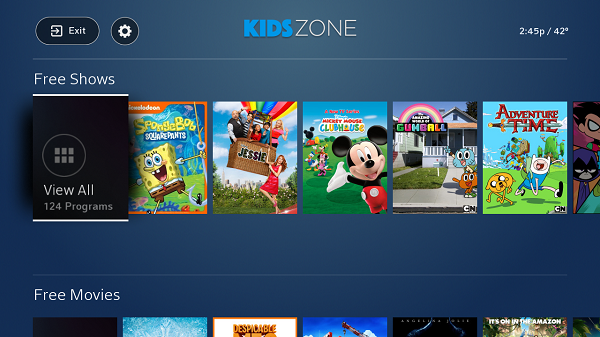As kids and parents are increasingly consuming online video content across multiple platforms including Netflix, Amazon and YouTube, traditional cabsat carriers are exploring new services that help close the linear/digital divide.
For Comcast, the largest cable provider in the US, its latest consumer-facing technology is Kids Zone—an intuitive, walled-off section on its X1 pay-TV, set-top-box platform. The new service is specifically designed for kids 12 and under to access free, age-appropriate TV shows and movies.
Unveiled in May, its protective features include optional parental controls that can filter programming by specific age ranges, disable the channel up/down button on the remote, and lock out the ability to purchase or rent programming.
The platform integrates age-based ratings and reviews from nonprofit org Common Sense Media for all of its programming, and the content is divided into four age categories (two to four, five to seven, eight to nine and 10 to 12).
Kids can easily locate recently watched shows, browse by their favorite kidsnets like Disney, Sprout and Nickelodeon, and sort by a number of themed categories such as “superheroes,” “outer space fun,” “talking pets” and “princesses.”
But aside from its claim to be the first walled-garden experience for kids provided by a pay-TV platform, a major point of differentiation for Kids Zone, says Comcast programming VP Andy Hunter, is that it seamlessly aggregates content from all platforms. Live TV, Xfinity On Demand’s free and paid VOD library, which includes more than 8,500 kids movies and TV shows and any saved programming on Comcast’s DVR, are all represented on Kids Zone.
Tapping its robust VOD offering has been a major focus for the cable operator, especially when it comes to kids.
“The scale is huge, and kids is our third-largest category, so it’s a big priority,” says Hunter.”Last year we did approximately 2.8 billion hours of VOD consumption overall, and we expect to do more than three billion hours in 2015,” he says.
“Roughly 70% of our customers use VOD on a monthly basis, and consumption is even higher on X1, where 85% of our customers use it monthly—we see up to a 35% lift in consumption on that platform compared to our native environment.”
Hunter adds that all types of kids content perform well on the platform, especially shows from the bigger networks.
In addition, many programs that have been on air, taken off, and put back on again are also doing well.
“It’s interesting to see that series like Hannah Montana and Full House are still relevant to a new generation of kids,” he notes.
And according to Comcast, several kids shows and terms have popped up in its top-50 most common commands for its new voice remote. Cartoon Network, Disney, Nickelodeon, SpongeBob, Teen Titans Go and Mickey Mouse are among the most heavily searched terms.
As far as data measurement goes, Hunter says the process has only just begun, but consumption patterns will be examined for every part of its Kids Zone guide and experience. “Then we’ll surface content in a way that is representative of those viewing habits,” he says.
For the short term, Comcast will continue to work with its content partners to provide a wider range of programming to drive usage. Its long-term plans, meanwhile, will focus on how technology can improve the X1 and Kids Zone experiences.
There are no plans at the moment to invest in original programming. “We have all the hits from the networks, so we feel pretty comfortable with our offering,” says Hunter.
One area he would like to see improve is Comcast’s ability to make its content more mobile.
“Of the 70% and 85% of our customers using the VOD platform on a monthly basis, roughly 35% of them use our TV Everywhere services, so we want to bring that up to parity,” he says.






















